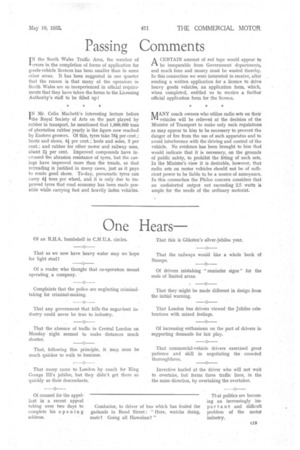Passing Comments
Page 77

If you've noticed an error in this article please click here to report it so we can fix it.
IN the South Wales Traffic Area, the number of ierrors in the completion of forms of application for goods-vehicle licences has been smaller than in some other areas. It has been suggested in one quarter that the reason is that many of the operators in South Wales are so inexperienced in official requirements that they have taken the forms to the Licensing Authority's staff to be filled up!
I N Mr. Colin Macbeth's interesting lecture before
the Royal Society of Arts on the part played by rubber in transport, he mentioned that 1,000,000 tons of plantation rubber yearly is the figure now reached by Eastern growers. Of this, tyres take 78-i per cent.; boots and shoes, 41i per cent.; heels and soles, 3 per cent.; and rubber for other motor and railway uses, about 21 per cent. Improved compounds have increased the abrasion resistance of tyres, but the casings have improved more than the treads, so that retreading is justified in many cases, just as it pays to resole good shoes. To-day, pneumatic tyres can carry 41 tons per wheel, and it is only due to improved tyres that road economy has been made possible while carrying fast and heavily laden vehicles. ACERTAIN amount of red tape would appear to be inseparable from Government departments, and much time and money must be wasted thereby. In this connection we were interested to receive, after sending a written application for a licence to drive heavy goods vehicles, an application form, which, when completed, entitled us to receive a further official application form for the licence.
iTANY coach owners who utilize radio sets on their IVI vehicles will be relieved at the decision of the Minister of Transport to make only such regulations as may appear to him to be necessary to prevent the danger of fire from the use of such apparatus and to avoid interference with theffriving and control of tho vehicle. No evidence has been brought to him that would indicate that it is necessary, on the grounds of public safety, to prohibit the fitting of such sets. In the Minister's view it is desirable, however, that radio sets on motor vehicles should not be of sufficient power to be liable to be a source of annoyance. In this connection the Philco concern considers that an undistorted output not exceeding 2.5 watts is ample for the needs of the ordinary motorist.




































































































































































